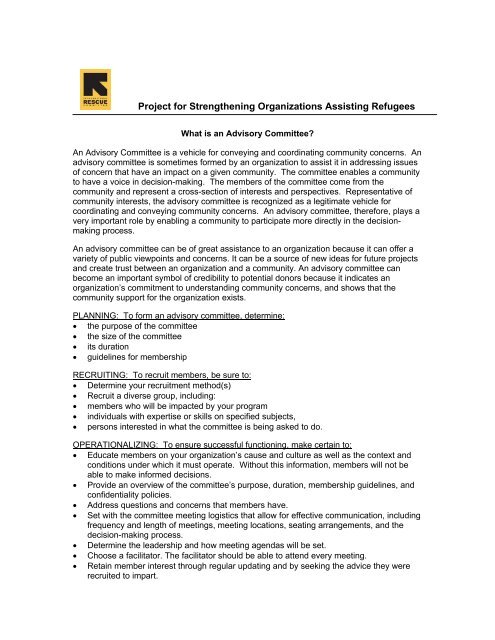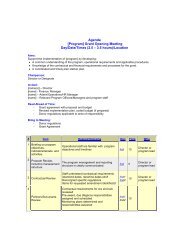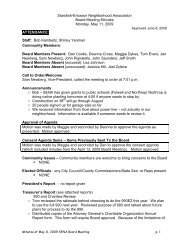What are Advisory and Steering Committees? - ethniccommunities.org
What are Advisory and Steering Committees? - ethniccommunities.org
What are Advisory and Steering Committees? - ethniccommunities.org
You also want an ePaper? Increase the reach of your titles
YUMPU automatically turns print PDFs into web optimized ePapers that Google loves.
Project for Strengthening Organizations Assisting Refugees<br />
<strong>What</strong> is an <strong>Advisory</strong> Committee?<br />
An <strong>Advisory</strong> Committee is a vehicle for conveying <strong>and</strong> coordinating community concerns. An<br />
advisory committee is sometimes formed by an <strong>org</strong>anization to assist it in addressing issues<br />
of concern that have an impact on a given community. The committee enables a community<br />
to have a voice in decision-making. The members of the committee come from the<br />
community <strong>and</strong> represent a cross-section of interests <strong>and</strong> perspectives. Representative of<br />
community interests, the advisory committee is recognized as a legitimate vehicle for<br />
coordinating <strong>and</strong> conveying community concerns. An advisory committee, therefore, plays a<br />
very important role by enabling a community to participate more directly in the decisionmaking<br />
process.<br />
An advisory committee can be of great assistance to an <strong>org</strong>anization because it can offer a<br />
variety of public viewpoints <strong>and</strong> concerns. It can be a source of new ideas for future projects<br />
<strong>and</strong> create trust between an <strong>org</strong>anization <strong>and</strong> a community. An advisory committee can<br />
become an important symbol of credibility to potential donors because it indicates an<br />
<strong>org</strong>anization’s commitment to underst<strong>and</strong>ing community concerns, <strong>and</strong> shows that the<br />
community support for the <strong>org</strong>anization exists.<br />
PLANNING: To form an advisory committee, determine:<br />
• the purpose of the committee<br />
• the size of the committee<br />
• its duration<br />
• guidelines for membership<br />
RECRUITING: To recruit members, be sure to:<br />
• Determine your recruitment method(s)<br />
• Recruit a diverse group, including:<br />
• members who will be impacted by your program<br />
• individuals with expertise or skills on specified subjects,<br />
• persons interested in what the committee is being asked to do.<br />
OPERATIONALIZING: To ensure successful functioning, make certain to:<br />
• Educate members on your <strong>org</strong>anization’s cause <strong>and</strong> culture as well as the context <strong>and</strong><br />
conditions under which it must operate. Without this information, members will not be<br />
able to make informed decisions.<br />
• Provide an overview of the committee’s purpose, duration, membership guidelines, <strong>and</strong><br />
confidentiality policies.<br />
• Address questions <strong>and</strong> concerns that members have.<br />
• Set with the committee meeting logistics that allow for effective communication, including<br />
frequency <strong>and</strong> length of meetings, meeting locations, seating arrangements, <strong>and</strong> the<br />
decision-making process.<br />
• Determine the leadership <strong>and</strong> how meeting agendas will be set.<br />
• Choose a facilitator. The facilitator should be able to attend every meeting.<br />
• Retain member interest through regular updating <strong>and</strong> by seeking the advice they were<br />
recruited to impart.
<strong>What</strong> is a <strong>Steering</strong> Committee?<br />
The <strong>Steering</strong> Committee provides support <strong>and</strong> guidance to an actual project. A project<br />
<strong>Steering</strong> Committee is a key body that ensures that the project attains its goals, objectives<br />
<strong>and</strong> outcomes, <strong>and</strong> is sustained. This may include developing <strong>and</strong> refining objectives,<br />
developing budgetary strategy, monitoring quality <strong>and</strong> timelines, <strong>and</strong> assessing requests for<br />
amendments to the scope of the project.<br />
Membership usually includes:<br />
• representatives from selected key stakeholders;<br />
• experts from within the agency; <strong>and</strong><br />
• external, independent representatives with expertise relevant to the project’s aims.<br />
The Project Manager is not a member of the <strong>Steering</strong> Committee. He or she works with the<br />
<strong>Steering</strong> Committee to ensure the work of the project is undertaken as agreed. The Project<br />
Manager should attend meetings of the <strong>Steering</strong> Committee. Additional staff such as a<br />
project team member or administrative staff may also attend.<br />
Collectively, the role of a <strong>Steering</strong> Committee is to:<br />
• ensure the project's scope aligns with the agreed requirements of the Business<br />
Owners <strong>and</strong> key stakeholder groups;<br />
• provide those directly involved in the project with guidance,<br />
• ensure that staff <strong>and</strong> volunteer effort <strong>and</strong> financial expenditure <strong>are</strong> appropriate to<br />
stakeholder expectations;<br />
• address issues which have major implications for the project;<br />
• maintain the project scope as emerging concerns force changes to be contemplated;<br />
• reconcile differences in opinion <strong>and</strong> approach <strong>and</strong> resolve disagreements;<br />
<strong>Steering</strong> Committee members do not hold any direct responsible for managing or<br />
implementing project activities. Rather, they provide support <strong>and</strong> guidance for those who<br />
do. Given those responsibilities, members of a <strong>Steering</strong> Committee should:<br />
• grasp the strategic implications <strong>and</strong> outcomes that <strong>are</strong> being pursued,<br />
• both appreciate the value of the project for some or all major stakeholders <strong>and</strong><br />
perhaps represent their interests;<br />
• possess a genuine interested in the project <strong>and</strong> its projected outcomes;<br />
• possess an underst<strong>and</strong>ing of project management in general <strong>and</strong> be familiar with the<br />
particular approach being used on this project.<br />
• advance positive communication outside of the Committee in relation to the project's<br />
progress;<br />
• monitor whether the project’s activities adhere to recognized st<strong>and</strong>ards of best<br />
practice both within the <strong>org</strong>anization <strong>and</strong> in the field in general.
















